在java中要想实现多线程,有两种手段,一种是继续Thread类,另外一种是实现Runable接口。
对于直接继承Thread的类来说,代码大致框架是:
class 类名 extends Thread{ 方法1; 方法2; … public void run(){ // other code… } 属性1; 属性2; … }
先看一个简单的例子:
class hello extends Thread { public hello() { } public hello(String name) { this.name = name; } public void run() { for (int i = 0; i < 5; i++) { System.out.println(name + "运行 " + i); } } public static void main(String[] args) { hello h1=new hello("A"); hello h2=new hello("B"); h1.run(); h2.run(); } private String name; }
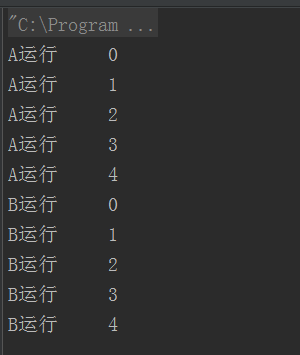
我们会发现这些都是顺序执行的,说明我们的调用方法不对,应该调用的是start()方法。当我们把上面的主函数修改为如下所示的时候:
public static void main(String[] args) {
hello h1=new hello("A");
hello h2=new hello("B");
h1.start();
h2.start();
}
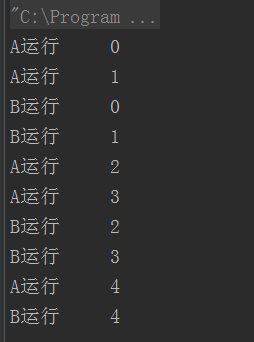
因为需要用到CPU的资源,所以每次的运行结果基本是都不一样的。
注意:虽然我们在这里调用的是start()方法,但是实际上调用的还是run()方法的主体。
那么:为什么我们不能直接调用run()方法呢?
我的理解是:线程的运行需要本地操作系统的支持。
如果你查看start的源代码的时候,会发现:
public synchronized void start() { /** * This method is not invoked for the main method thread or "system" * group threads created/set up by the VM. Any new functionality added * to this method in the future may have to also be added to the VM. * * A zero status value corresponds to state "NEW". */ if (threadStatus != 0 || this != me) throw new IllegalThreadStateException(); group.add(this); start0(); if (stopBeforeStart) { stop0(throwableFromStop); } } private native void start0();
注意最后一条语句,说明此处调用的是start0()。并且这个这个方法用了native关键字,次关键字表示调用本地操作系统的函数。因为多线程的实现需要本地操作系统的支持。但是start方法重复调用的话,会出现java.lang.IllegalThreadStateException异常。
通过实现Runnable接口
大致框架是:
class 类名 implements Runnable{ 方法1; 方法2; … public void run(){ // other code… } 属性1; 属性2; … }
来先看一个小例子吧:
class hello implements Runnable {
public hello() {
}
public hello(String name) {
this.name = name;
}
public void run() {
for (int i = 0; i < 5; i++) {
System.out.println(name + "运行 " + i);
}
}
public static void main(String[] args) {
hello h1=new hello("线程A");
Thread demo= new Thread(h1);
hello h2=new hello("线程B");
Thread demo1=new Thread(h2);
demo.start();
demo1.start();
}
private String name;
}
关于选择继承Thread还是实现Runnable接口?
其实Thread也是实现Runnable接口的:
class Thread implements Runnable {
//…
public void run() {
if (target != null) {
target.run();
}
}
}
Thread和Runnable的区别:
如果一个类继承Thread,则不适合资源共享。但是如果实现了Runable接口的话,则很容易的实现资源共享。
class hello extends Thread {
public void run() {
for (int i = 0; i < 7; i++) {
if (count > 0) {
System.out.println("count= " + count--);
}
}
}
public static void main(String[] args) {
hello h1 = new hello();
hello h2 = new hello();
hello h3 = new hello();
h1.start();
h2.start();
h3.start();
}
private int count = 5;
}
大家可以想象,如果这个是一个买票系统的话,如果count表示的是车票的数量的话,说明并没有实现资源的共享。
我们换为Runnable接口
class MyThread implements Runnable{
private int ticket = 5; //5张票
public void run() {
for (int i=0; i<=20; i++) {
if (this.ticket > 0) {
System.out.println(Thread.currentThread().getName()+ "正在卖票"+this.ticket--);
}
}
}
}
public class lzwCode {
public static void main(String [] args) {
MyThread my = new MyThread();
new Thread(my, "1号窗口").start();
new Thread(my, "2号窗口").start();
new Thread(my, "3号窗口").start();
}
}
总结一下吧:
实现Runnable接口比继承Thread类所具有的优势:
1):适合多个相同的程序代码的线程去处理同一个资源
2):可以避免java中的单继承的限制
3):增加程序的健壮性,代码可以被多个线程共享,代码和数据独立。
所以,本人建议大家劲量实现接口。
线程的名称:
class hello implements Runnable {
public void run() {
for (int i = 0; i < 3; i++) {
System.out.println(Thread.currentThread().getName());
}
}
public static void main(String[] args) {
hello he = new hello();
new Thread(he,"A").start();
new Thread(he,"B").start();
new Thread(he).start();
}
}
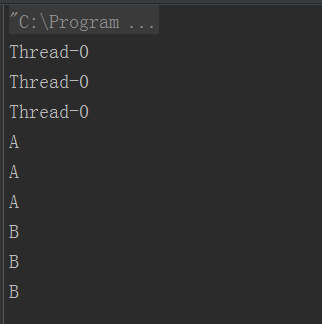
说明如果我们没有指定名字的话,系统自动提供名字。
提醒一下大家:main方法其实也是一个线程。在java中所以的线程都是同时启动的,至于什么时候,哪个先执行,完全看谁先得到CPU的资源。
在java中,每次程序运行至少启动2个线程。一个是main线程,一个是垃圾收集线程。因为每当使用java命令执行一个类的时候,实际上都会启动一个JVM,每一个JVM实际在就是在操作系统中启动了一个进程。
判断线程是否启动
package demos;
public class hello implements Runnable {
public void run() {
for (int i = 0; i < 3; i++) {
System.out.println(Thread.currentThread().getName());
}
}
public static void main(String[] args) {
hello he = new hello();
Thread demo = new Thread(he);
System.out.println("线程启动之前---》" + demo.isAlive());
demo.start();
System.out.println("线程启动之后---》" + demo.isAlive());
}
}
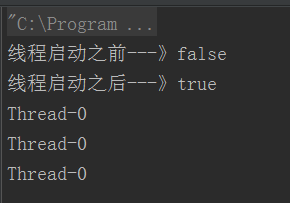
主线程也有可能在子线程结束之前结束。并且子线程不受影响,不会因为主线程的结束而结束。
线程的强制执行:
package demos; public class hello implements Runnable { public void run() { for (int i = 0; i < 3; i++) { System.out.println(Thread.currentThread().getName()); } } public static void main(String[] args) { hello he = new hello(); Thread demo = new Thread(he, "线程"); demo.start(); for(int i=0;i<50;++i){ if (i > 10) { try{ demo.join(); //强制执行demo }catch (Exception e) { e.printStackTrace(); } } System.out.println("main 线程执行-->"+i); } } }

线程的休眠:
package demos;
public class hello implements Runnable {
public void run() {
for (int i = 0; i < 3; i++) {
try {
Thread.sleep(2000);
} catch (Exception e) {
e.printStackTrace();
}
System.out.println(Thread.currentThread().getName() + i);
}
}
public static void main(String[] args) {
hello he = new hello();
Thread demo = new Thread(he, "线程");
demo.start();
}
}
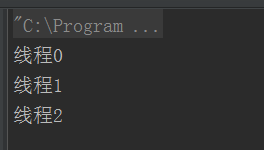
线程中断:
package demos;
public class hello implements Runnable {
public void run() {
System.out.println("执行run方法");
try {
Thread.sleep(10000);
System.out.println("线程完成休眠");
} catch (Exception e) {
System.out.println("休眠被打断");
return; //返回到程序的调用处
}
System.out.println("线程正常终止");
}
public static void main(String[] args) {
hello he = new hello();
Thread demo = new Thread(he, "线程");
demo.start();
try{
Thread.sleep(2000);
}catch (Exception e) {
e.printStackTrace();
}
demo.interrupt(); //2s后中断线程
}
}

在java程序中,只要前台有一个线程在运行,整个java程序进程不会消失,所以此时可以设置一个后台线程,这样即使java进程消失了,此后台线程依然能够继续运行。
package demos;
public class hello implements Runnable {
public void run() {
while (true) {
System.out.println(Thread.currentThread().getName() + "在运行");
}
}
public static void main(String[] args) {
hello he = new hello();
Thread demo = new Thread(he, "线程");
demo.setDaemon(true);
demo.start();
}
}
虽然有一个死循环,但是程序还是可以执行完的。因为在死循环中的线程操作已经设置为后台运行了。
线程的优先级:
package demos;
public class hello implements Runnable {
public void run() {
for(int i=0;i<5;++i){
System.out.println(Thread.currentThread().getName()+"运行"+i);
}
}
public static void main(String[] args) {
Thread h1=new Thread(new hello(),"A");
Thread h2=new Thread(new hello(),"B");
Thread h3=new Thread(new hello(),"C");
h1.setPriority(8);
h2.setPriority(2);
h3.setPriority(6);
h1.start();
h2.start();
h3.start();
}
}
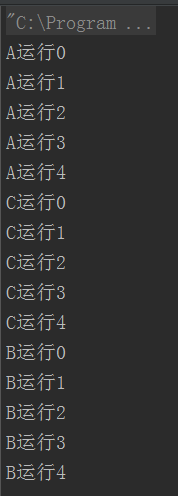
但是不要误以为优先级越高就先执行。谁先执行还是取决于谁先取得CPU的资源。另外,主线程的优先级是5.
线程的礼让:
在线程操作中,也可以使用yield()方法,将一个线程的操作暂时交给其他线程执行。
package demos;
public class hello implements Runnable {
public void run() {
for(int i=0;i<5;++i){
System.out.println(Thread.currentThread().getName()+"运行"+i);
if(i==3){
System.out.println("线程的礼让");
Thread.currentThread().yield();
}
}
}
public static void main(String[] args) {
Thread h1=new Thread(new hello(),"A");
Thread h2=new Thread(new hello(),"B");
h1.start();
h2.start();
}
}

同步和死锁:
package demos;
public class hello implements Runnable {
public void run() {
for(int i=0;i<10;++i){
if(count>0){
try{
Thread.sleep(1000);
}catch(InterruptedException e){
e.printStackTrace();
}
System.out.println(count--);
}
}
}
public static void main(String[] args) {
hello he=new hello();
Thread h1=new Thread(he);
Thread h2=new Thread(he);
Thread h3=new Thread(he);
h1.start();
h2.start();
h3.start();
}
private int count=5;
}
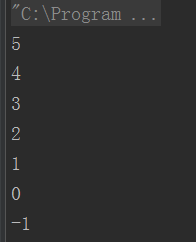
这里出现了-1,显然这个是错的。,应该票数不能为负值。
如果想解决这种问题,就需要使用同步。所谓同步就是在统一时间段中只有有一个线程运行,
其他的线程必须等到这个线程结束之后才能继续执行。
【同步代码块】:
语法格式:
synchronized(同步对象){
//需要同步的代码
}
但是一般都把当前对象this作为同步对象。
比如对于上面的买票的问题,如下:
package demos; public class hello implements Runnable { public void run() { for(int i=0;i<10;++i){ synchronized (this) { if(count>0){ try{ Thread.sleep(1000); }catch(InterruptedException e){ e.printStackTrace(); } System.out.println(count--); } } } } public static void main(String[] args) { hello he=new hello(); Thread h1=new Thread(he); Thread h2=new Thread(he); Thread h3=new Thread(he); h1.start(); h2.start(); h3.start(); } private int count=5; }

也可以采用同步方法。
语法格式为synchronized 方法返回类型方法名(参数列表){
// 其他代码
}
现在,我们采用同步方法解决上面的问题。
class hello implements Runnable {
public void run() {
for (int i = 0; i < 10; ++i) {
sale();
}
}
public synchronized void sale() {
if (count > 0) {
try {
Thread.sleep(1000);
} catch (InterruptedException e) {
e.printStackTrace();
}
System.out.println(count--);
}
}
public static void main(String[] args) {
hello he = new hello();
Thread h1 = new Thread(he);
Thread h2 = new Thread(he);
Thread h3 = new Thread(he);
h1.start();
h2.start();
h3.start();
}
private int count = 5;
}
提醒一下,当多个线程共享一个资源的时候需要进行同步,但是过多的同步可能导致死锁。
此处列举经典的生产者和消费者问题。
【生产者和消费者问题】
先看一段有问题的代码。
package demos; class Info { public String getName() { return name; } public void setName(String name) { this.name = name; } public int getAge() { return age; } public void setAge(int age) { this.age = age; } private String name = "Rollen"; private int age = 20; } /** * 生产者 * */ class Producer implements Runnable{ private Info info=null; Producer(Info info){ this.info=info; } public void run(){ boolean flag=false; for(int i=0;i<25;++i){ if(flag){ this.info.setName("Rollen"); try{ Thread.sleep(100); }catch (Exception e) { e.printStackTrace(); } this.info.setAge(20); flag=false; }else{ this.info.setName("chunGe"); try{ Thread.sleep(100); }catch (Exception e) { e.printStackTrace(); } this.info.setAge(100); flag=true; } } } } /** * 消费者类 * */ class Consumer implements Runnable{ private Info info=null; public Consumer(Info info){ this.info=info; } public void run(){ for(int i=0;i<25;++i){ try{ Thread.sleep(100); }catch (Exception e) { e.printStackTrace(); } System.out.println(this.info.getName()+"<---->"+this.info.getAge()); } } } /** * 测试类 * */ public class hello{ public static void main(String[] args) { Info info=new Info(); Producer pro=new Producer(info); Consumer con=new Consumer(info); new Thread(pro).start(); new Thread(con).start(); } }
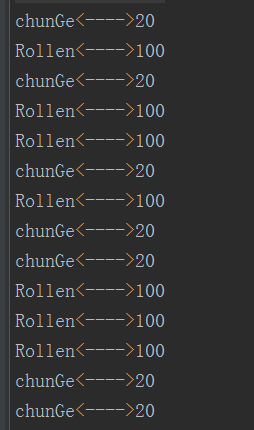
大家可以从结果中看到,名字和年龄并没有对应。
那么如何解决呢?
1)加入同步
2)加入等待和唤醒
先来看看加入同步会是如何:
class Info { public String getName() { return name; } public void setName(String name) { this.name = name; } public int getAge() { return age; } public void setAge(int age) { this.age = age; } public synchronized void set(String name, int age){ this.name=name; try{ Thread.sleep(100); }catch (Exception e) { e.printStackTrace(); } this.age=age; } public synchronized void get(){ try{ Thread.sleep(100); }catch (Exception e) { e.printStackTrace(); } System.out.println(this.getName()+"<===>"+this.getAge()); } private String name = "Rollen"; private int age = 20; } /** * 生产者 * */ class Producer implements Runnable { private Info info = null; Producer(Info info) { this.info = info; } public void run() { boolean flag = false; for (int i = 0; i < 25; ++i) { if (flag) { this.info.set("Rollen", 20); flag = false; } else { this.info.set("ChunGe", 100); flag = true; } } } } /** * 消费者类 * */ class Consumer implements Runnable { private Info info = null; public Consumer(Info info) { this.info = info; } public void run() { for (int i = 0; i < 25; ++i) { try { Thread.sleep(100); } catch (Exception e) { e.printStackTrace(); } this.info.get(); } } } /** * 测试类 * */ class hello { public static void main(String[] args) { Info info = new Info(); Producer pro = new Producer(info); Consumer con = new Consumer(info); new Thread(pro).start(); new Thread(con).start(); } }
这样问题就解决了,所有的年龄和名字都正确对应了起来。
但是还是出现了重复读取的问题,也肯定有重复覆盖的问题。如果想解决这个问题,就需要使用Object类帮忙了、,我们可以使用其中的等待和唤醒操作。
要完成上面的功能,我们只需要修改Info类饥渴,在其中加上标志位,并且通过判断标志位完成等待和唤醒的操作,代码如下:
class Info { public String getName() { return name; } public void setName(String name) { this.name = name; } public int getAge() { return age; } public void setAge(int age) { this.age = age; } public synchronized void set(String name, int age){ if(!flag){ try{ super.wait(); }catch (Exception e) { e.printStackTrace(); } } this.name=name; try{ Thread.sleep(100); }catch (Exception e) { e.printStackTrace(); } this.age=age; flag=false; super.notify(); } public synchronized void get(){ if(flag){ try{ super.wait(); }catch (Exception e) { e.printStackTrace(); } } try{ Thread.sleep(100); }catch (Exception e) { e.printStackTrace(); } System.out.println(this.getName()+"<===>"+this.getAge()); flag=true; super.notify(); } private String name = "Rollen"; private int age = 20; private boolean flag=false; } /** * 生产者 * */ class Producer implements Runnable { private Info info = null; Producer(Info info) { this.info = info; } public void run() { boolean flag = false; for (int i = 0; i < 25; ++i) { if (flag) { this.info.set("Rollen", 20); flag = false; } else { this.info.set("ChunGe", 100); flag = true; } } } } /** * 消费者类 * */ class Consumer implements Runnable { private Info info = null; public Consumer(Info info) { this.info = info; } public void run() { for (int i = 0; i < 25; ++i) { try { Thread.sleep(100); } catch (Exception e) { e.printStackTrace(); } this.info.get(); } } } /** * 测试类 * */ class hello { public static void main(String[] args) { Info info = new Info(); Producer pro = new Producer(info); Consumer con = new Consumer(info); new Thread(pro).start(); new Thread(con).start(); } }